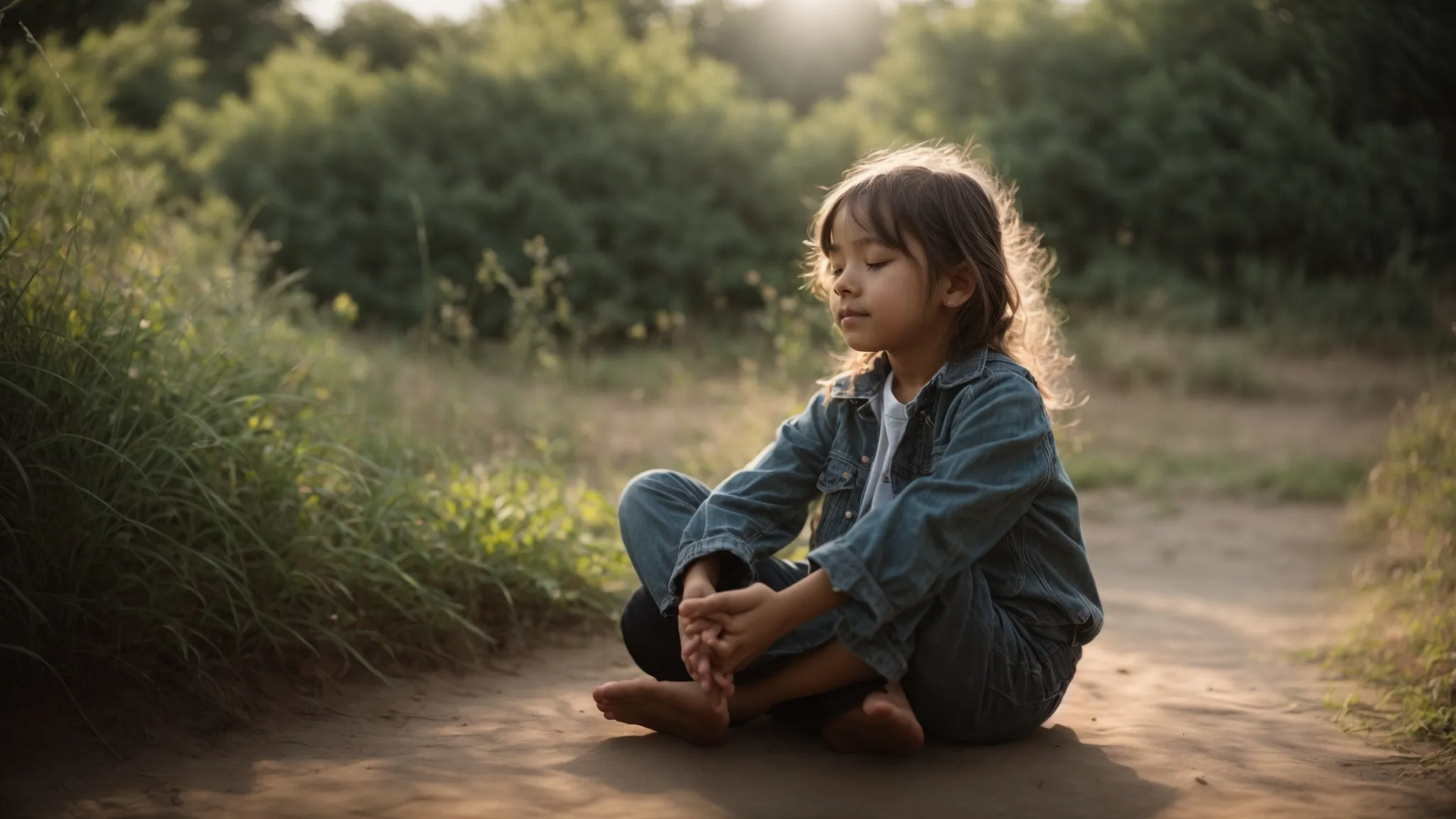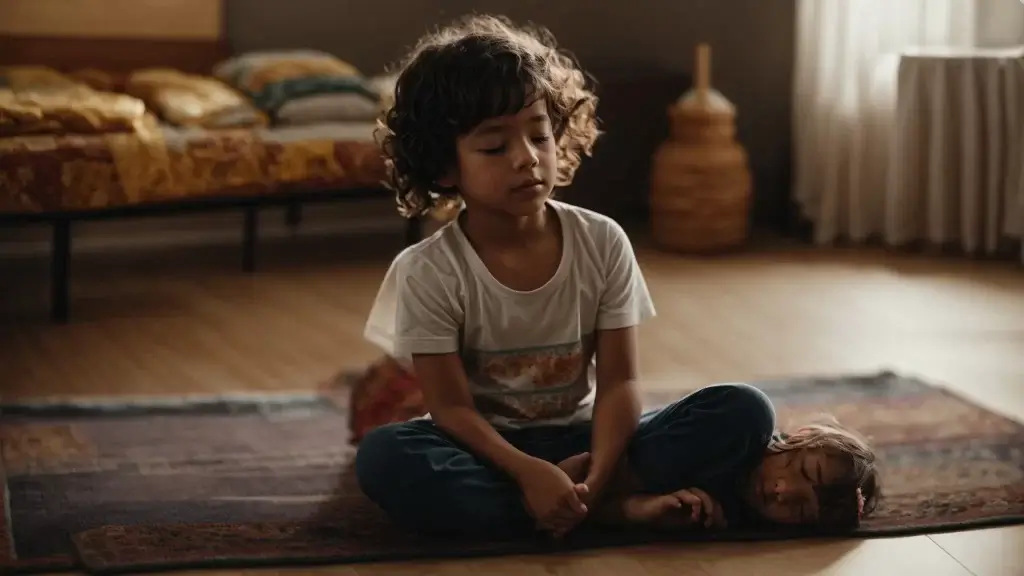What Is Box Breathing?
In the labyrinth of relaxation techniques that promise tranquility and a fortified mental state, box breathing emerges as a beacon of simplicity and effectiveness.
This method, embraced by the likes of the United States Navy SEALs, transforms the act of breathing from an autonomic function into a powerful tool for managing stress and anxiety.
By rhythmically syncing inhalation, hold, exhalation, and pause, box breathing weaves a pattern that anchors the mind, facilitating a profound connection between the body and its most primal function: breath.
It incites an orchestra within, where every breath is a note, every pause a rest, creating a melody of calmness.
Keep reading to explore how this simple yet potent practice can be the key to unlocking a world of serenity and heightened health for your child.
Key Takeaways
- Box Breathing Is a Structured Method That Fosters Both Physical and Mental Relaxation, Enhancing Overall Well-Being
- Proper Breathing Practices From an Early Age Can Build a Resilient Immune System, Improve Psychological Health, and Increase Attention Spans in Children
- Through Fostering Tranquility and Self-Awareness, Box Breathing Empowers Children to Navigate Stress and Emotional Challenges With Improved Resilience
- Consistent Practice of Box Breathing Can Sharpen Mental Clarity and Focus, Aiding in Educational and Daily Activities
- Integrating Box Breathing Into Daily Routines Establishes a Foundation for Long-Term Stress Management and Emotional Intelligence
The box breathing method

Box breathing, a technique where the rhythm of breath becomes a tool for calming the tempest within, stands as a beacon of tranquility. Named for its structured pattern, this method unfolds in four parts, each holding its breath, so to speak, as a sentinel at the gates of relaxation. It’s not merely about inhaling and exhaling; it’s about drawing a square in the mind’s eye, each side a steady guide to deeper peace.
Within the sanctum of this practice, the individual initiates with a slow inhalation through the nose, counting to four, filling the lungs with a bounty of oxygen. The pause that follows isn’t a void but a space brimming with potential, where for another count of four, the breath is held hostage by will, permitting the body to absorb the life-affirming element. It’s in this moment that stress begins to unbuckle its grip, allowing the heart rate to dance to a slower rhythm.
The exhalation ensues, not as an act of surrender but as a deliberate release, whispering through the mouth or nose over a tranquil count of four. This step, often overlooked in the hustle of daily life, commands an exodus of carbon dioxide, the byproduct of our survival. Accompanied by another measured pause, the cycle prepares to begin anew, the body a vessel cleared for the next breath’s journey.
In embracing box breathing, a bridge forms between the corporeal and the cerebral, the muscles’ tension easing as the mind finds solace. This method, utilized by United States Navy SEALs and embraced across realms of psychotherapy and stress management, shines as a testament to the profound influence of breath on our physical and mental health. It underscores a fundamental truth – that within each inhalation and exhalation lays the power to sculpt our inner realm.
As we navigate the calming waters of the box breathing method, let’s plunge into the heart of why each breath is a cornerstone of a child’s vibrant health. Ready your mind, for this journey unlocks the secrets woven into the very fabric of youthful well-being.
Another great article for parents is “Empower Your Child With the Yes I Can Attitude.”
Why breath is vital to a child’s health

Breath, the silent whisper underpinning the rhythm of life, becomes especially crucial in the tapestry of a child’s health. From the moment of birth, the act of breathing not only fuels the body with essential oxygen but also initiates the delicate dance of growth and development. It is the cornerstone of existence, influencing every cell, and every heartbeat.
For children, the quality of breath intertwines with the multifaceted aspects of their well-being. Proper breathing patterns can fortify the immune system, reduce the frequency of anxiety-driven episodes, and enhance attention spans, laying a solid foundation for robust health. This harmonious balance of inhalation and exhalation serves as a guardian against the intrusion of stress in early childhood, a period marked by rapid physiological and psychological changes.
| Aspect of Health | Impact of Proper Breathing |
|---|---|
| Immune System | Strengthened Defense |
| Psychological Well-being | Reduced Anxiety Episodes |
| Attention Span | Enhanced Focus |
| Early Childhood Stress | Increased Resilience |
The act of breathing deeply, such as through practices like box breathing, introduces a sense of calm and security: a shelter in the storm of emotions and experiences that buffet the sensitive shores of a child’s world. This sense of tranquility cascades into a myriad of benefits, from improved sleep patterns to better management of emotions, aiding in the navigation through life’s ebb and flow.
Moreover, in a society where stress and anxiety disorders cast a long shadow, equipping children with techniques like box breathing empowers them with a lifelong tool for coping. It is a skill that, once learned, becomes a beacon of control and confidence amidst the torrents of change, a profound testament to the adage that sometimes, the mightiest strength lies in a single breath.
The journey from understanding breath’s paramount role in a child’s wellness to discovering a powerful tool is about to unfold. Let’s explore the transformative benefits of box breathing for your little ones.
Benefits of box breathing for your child

Box breathing emerges as a resolute ally in the quest to shield one’s child from the pernicious claws of stress, charting a course toward a harmonious state of being.
This method is not just a mere act of breathing but a deeply transformative practice that intertwines the physical with the emotional, laying down pathways for enhanced mental clarity, focus, and energy.
By guiding the young ones through the rhythmic patterns of box breathing, caregivers plant the seeds for a robust coping mechanism, cultivating resilience that does more than just mitigate the immediate symptoms of physical stress.
It reshapes their very approach to stress, molding their responses to future challenges with a calmness and clarity that stand as pillars of strength in the tumultuous landscape of growth and development.
Reduces physical stress symptoms in the body
Embarking on the journey of box breathing, a child embarks on a tranquil voyage where the tumultuous waves of physical stress are gently calmed. This method acts as an anchor, steadying the fluctuating tides of muscle tension and heart rate, thereby fostering an environment where the body can reclaim its state of equilibrium.
| Physical Symptom | Impact of Box Breathing |
|---|---|
| Heart Rate | Reduces and Stabilizes |
| Muscle Tension | Diminishes |
| Blood Pressure | Lowers |
Through the disciplined harmony of breath, each inhalation and exhalation serves as a brushstroke in the masterpiece of tranquility, effectively soothing the distressed symphony of the nervous system. The result: a significant reduction in the manifestations of physical stress, allowing the child to navigate through life’s storms with a serene disposition and fortified resilience.
Positively affects emotions and mental well-being
Box breathing stands as a lighthouse, guiding the tumultuous sea of emotions toward a harbor of serenity. This practice fosters an enhanced sense of self-awareness, allowing children to recognize and navigate their emotions with grace and maturity: a skill that lays the groundwork for a resilient mental well-being.
| Emotional Aspect | Impact of Box Breathing |
|---|---|
| Self-Awareness | Increases Clarity and Reflection |
| Mental Resilience | Strengthens Emotional Fortitude |
Moreover, by instilling this tranquil discipline, one nurtures a child’s ability to remain anchored in moments of psychological stress, reducing the likelihood of anxiety and fostering a fortified sense of calm. This transformation not only tempers the immediate storm of overwhelming feelings but also builds a robust foundation for enduring emotional wellness.
Increases mental clarity, energy, and focus
Box breathing illuminates the path to heightened mental clarity, serving as a catalyst for sharpening the focus. Through the structured rhythm of breath, it slices through the haze of distraction, allowing a child to hone in on tasks with laser precision: a skill particularly beneficial in educational settings and daily learning.
- Initiates a steady flow of oxygen, enhancing brain function.
- Calms the mind’s chatter, facilitating deeper concentration.
- Rejuvenates the body and mind, boosting energy levels for sustained attention.
This practice not only elevates a young learner’s ability to concentrate but also imbues them with a reservoir of energy. The tranquility fostered by box breathing paves the way for an uninterrupted flow of vitality, ensuring that fatigue does not cloud their mental state, thereby maintaining an unflagging focus across the day’s array of activities and challenges.
Improves future reactions to stress
Box breathing, with its methodical cadence, equips children with the prowess to face stress not as an insurmountable titan but as a surmountable challenge: it reshapes their perception of stressors, transforming future encounters into opportunities for growth rather than sources of dread. This practice arms them with a steadiness, making the peaks and valleys of life’s stressors navigable with resilience and grace.
| Future Stress Reaction Aspect | Impact of Box Breathing |
|---|---|
| Perception of Stress | Transformed into Growth Opportunities |
| Resilience and Grace | Enhanced Ability to Navigate Stress |
The breath becomes a beacon of empowerment, teaching children that they command the sails of their emotional and psychological ships amidst the stormy seas of life. By instilling this invaluable skill early on, box breathing ensures a legacy of emotional intelligence and a fortified mind, ready to encounter the stress of tomorrow with confidence and calm.
Now that we’ve uncovered the treasures box breathing can offer your child, let’s gear up for the next adventure. Prepare to master the art of box breathing with these practical tips!
Tips for Box Breathing with Your Child

To embark on the journey of box breathing, one must first seek a sanctuary of serenity, devoid of distractions that might dilute the essence of the practice. Selecting a quiet corner envelops the individual in an atmosphere conducive to mindfulness, setting the stage for a more profound and uninterrupted experience.
Initiating this breathing exercise with an open mind and a posture that marries comfort with alertness amplifies its benefits. Sitting upright in a chair or on a cushion with the back straight, yet not rigid, encourages the free flow of breath through the body, bridging the gap between physical relaxation and mental tranquility.
As the practitioner commences with the inhalation through the nose, allowing the air to gently swell the abdomen before rising to fill the lungs, they cultivate a deep awareness of the life force that breathes vitality into every cell. This mindful approach to breathing, where attention is lavished on each phase of the breath, fosters a connection with the present moment, diluting the echoes of past worries and future anxieties.
Consistency in practice crowns the endeavor with success, transforming box breathing from a mere exercise into a transformative ritual. Embedding this practice into daily routines, whether as a morning invigoration or a nocturnal bridge to restful sleep, paves the way for lasting resilience against the ebb and flow of life’s stresses.
Frequently Asked Questions
What is the box breathing method and how does it work?
The box breathing method, a jewel in the crown of relaxation techniques, embodies a rhythmic dance of inhalation and exhalation performed in equal, four-count measures, creating an invisible square of serene balance in the tempest of our minds. It operates on the principle of controlled breaths, wielding the power to recalibrate the nervous system, bringing a banquet of calm to the often tumultuous feast of emotions.
Why is proper breathing vital to a child’s health and development?
Proper breathing forms the bedrock upon which a child’s health and developmental milestones firmly stand, serving as a silent guardian that weaves resilience into their burgeoning lives. It is through the rhythmic dance of inhalation and exhalation that the young ones harness the power to combat stress, nurture their nervous systems, and fortify their mental and physical well-being.
In the realm of pediatrics, the art and science of breathing reveal a tapestry of benefits, each thread intricately connected to the other. The act of drawing air through the nose, a seemingly mundane task, acts as a cornerstone in regulating the autonomic nervous system. It’s a balancing act where the sympathetic and parasympathetic systems, like two sides of the same coin, work in harmony to foster a state of calmness amidst the storm of daily stresses.
Imagine, if you will, a world where every breath taken by a child is likened to a gentle brushstroke on the canvas of their development. Diaphragmatic breathing, a technique often overlooked in its simplicity, invites the abdomen to rise and fall like the tide, these motions sending signals of tranquility to the brain. This is not merely about oxygen meeting lung; it’s a ballet of biological processes where heart rate slows, blood pressure whispers softer, and muscles relinquish their iron grip on tension.
Yet, the journey of a breath holds more than meets the eye. In the echo of each exhalation lies the capability to sweep away the cobwebs of anxiety, ushering an era of peace within the chambers of a child’s heart. Researchers have embroidered this understanding into methodologies like pranayama and biofeedback, practices enshrined in the wisdom of alternative medicine yet celebrated in the rigorous examination of modern science.
The narrative of stress in early childhood is a poignant reminder of the hurdles children face. From the shadows of anxiety disorders to the specter of chronic pain, these are not merely challenges but risk factors capable of altering the trajectory of a child’s life. Breathing, in its essence, becomes a fortress, offering protection against the torrents of psychological stress and the aftershocks of traumatic experiences.
Moreover, the domain of relaxation techniques, such as progressive muscle relaxation and guided imagery, hosts a chorus of interventions aimed at teaching children the language of their breath. Like sailors navigating the unpredictable seas, children learn to wield their breathing as an anchor, steadying themselves against the waves of emotion and cognition that threaten to upend their vessel.
In educational settings, the introduction of breathing exercises has shown a golden path towards enhancing attention, mitigating the effects of anxiety, and promoting a conducive learning environment. The classroom transforms into a sanctuary where the seeds of mindfulness are planted, growing into resilient saplings under the nurturing sun of breathwork.
Hence, in the tapestry of a child’s life, where each thread represents a facet of their being, proper breathing emerges as a master weaver. It intertwines the fibres of physical health with the strands of emotional and psychological resilience, crafting a garment of wellbeing that shields them from the elements of stress and disease. The breath becomes a silent melody, a lullaby that soothes the nerves, comforts the mind, and heals the body, guiding the young ones on their journey towards a harmonious development.
The narrative elegantly expounds on the virtues of box breathing as an essential thread in the fabric of a child’s development, emphasizing its role as both an emotional anchor and a tool for nurturing mental resilience. In a world fraught with challenges, it positions this practice as a guiding light towards tranquility and emotional stability, enriching the bond between parent and child through shared moments of peace and self-control.
How can box breathing help children cope with stress and anxiety?
Box breathing, a simple yet profound relaxation technique, stands as a beacon of calm amidst the storm of stress and anxiety for children. By guiding them through a rhythmic dance of inhalation, holding, exhalation, and pausing, this method equips young minds with the armor to battle the invisible foes of worry and fear.
In the bustling life of a child, where each day is a rollercoaster of emotions—from the peaks of joy to the valleys of dismay—stress can be a relentless pursuer. Whether it stems from academic pressure, social dynamics, or the echoes of stress in early childhood, the shadow of anxiety often looms large. Amidst these swirling winds, the gentle yet powerful practice of box breathing emerges as a lighthouse guiding ships to shore, offering a haven of peace in the tumultuous ocean of a child’s world.
Imagine, if you will, a child seated cross-legged, their attention anchored in the moment. With each slow, deliberate inhalation through the nose, their chest and abdomen gently rise, drawing in life’s vital essence—oxygen. As they pause, a moment of stillness envelops them, the world outside fades, and a serene inner landscape unveils. The gradual exhalation that follows is not merely the release of carbon dioxide but the unburdening of stress, the whispers of worry dissolving into the ether. Another pause—the beat of silence in music—caps off this four-sided square of breathing, instilling a profound sense of calmness.
Box breathing, akin to the ebb and flow of tides, synchronizes the rhythm of breath with the natural pace of the parasympathetic nervous system. This gentle nudging towards equilibrium whispers to the body, “All is well,” slowing the heart rate, reducing blood pressure, and swaddling the nervous system in a cocoon of tranquility. For children, whose worlds are often rent with the sharp edges of stress and anxiety, this technique is not just a practice but a sanctuary.
Parents and caregivers, akin to nurturing shepherds, play an indispensable role in this process. By integrating box breathing into their toolkits, they arm their children not with a shield against experiencing emotions but with the strength to ride the waves of their feelings. Empowering children with this technique imbues them not just with a method to quell the tempest of the moment but with a lifelong skill for managing stress and anxiety.
Beyond its immediate calming effects, regular engagement with box breathing fosters a heightened state of mindfulness and awareness. Like planting seeds in fertile soil, teaching children this method sows the foundations of emotional resilience, preparing them to face life’s challenges with grace and fortitude. As they grow, so too does their capacity for self-regulation, transforming what was once a coping mechanism into a pillar of their mental health.
In essence, box breathing offers more than just a temporary respite from stress and anxiety; it is a gateway to a richer, more balanced emotional life for children. It teaches them that within their breath lies the power to navigate the storms of life, not by avoiding them, but by moving through them with confidence and peace. In the tapestry of techniques aimed at enhancing the well-being of our young, box breathing stands out as a simple, accessible thread, weaving strength and serenity into the fabric of their daily existence.
What are some tips to effectively practice box breathing with your child?
In the dance of daily life, where stress often takes the stage, teaching a child the art of box breathing becomes both a shield and a soothing balm. To embark on this journey toward tranquility, begin by embracing patience and understanding, guiding your child with gentle encouragement as they learn to harmonize their breath with the rhythmic beats of calmness.
Start with a serene setting, a canvas where the clamor of the external world fades, allowing focus and calmness to paint the moment. This could be a quiet corner of their room, a cozy nook bathed in soft light, or even a beloved spot in nature where the whisper of the wind complements the exercise.
Language is a powerful tool; use it to weave a tale that captures their imagination. Describe box breathing as a superhero’s technique to summon calm or as a secret skill used by characters from their favorite stories. This not only garners their interest but also secures their engagement through the power of storytelling.
Demonstrate the technique with exaggerated motions, breaking down each step—inhale, hold, exhale, hold—into a visual performance. Encourage them to mirror you, making it a shared experience. Utilize props like feathers to illustrate the gentleness of breath or bubbles to show the rhythm of breathing in a tangible, playful manner.
Incorporate game elements to transform practice into play. Set challenges with fun rewards, turning the mastery of each stage of box breathing into an adventure. Encourage them to lead the practice, empowering them with responsibility and boosting their confidence.
Ensure the practice is not a rigid regimen but a fluid melody that adapts to the day’s ebbs and flows. Short sessions interwoven with laughter and lightness make the learning process enjoyable and less daunting for the young mind.
For the guiding adult, patience is a virtue to be cherished. Mistakes and distractions are not hurdles but stepping stones. Each moment of wandering attention is an opportunity to gently realign focus, reinforcing the practice without the shadow of frustration.
Remember, the journey is as important as the destination. Celebrate progress, however small, nurturing a sense of achievement and pride in their newfound skill. This shared journey not only aids in stress management but strengthens the bonds, creating a sanctuary of calm in the whirlwind of life.
In essence, the practice of box breathing with your child is a tapestry of patience, imagination, play, and encouragement. It is a path trodden together, where each step is a discovery, each breath a bridge to calmness, woven into the fabric of daily life, transforming moments of stress into opportunities for connection, growth, and serenity.
Conclusion
Box breathing emerges as a powerful technique for achieving tranquility and enhancing both physical and mental health.
By methodically following a pattern of inhaling, holding, and exhaling breath, individuals can reduce stress, improve focus, and foster emotional resilience.
This practice, notable for its use among Navy SEALs and in psychotherapy, underscores the profound impact of breathing on our overall well-being.
It’s particularly beneficial for children, bolstering their immune system, enhancing attention spans, and increasing their capacity to handle stress with grace.
By incorporating box breathing into daily routines, one cultivates a robust mechanism for coping with life’s challenges, thereby paving the way for lasting health and emotional intelligence.

